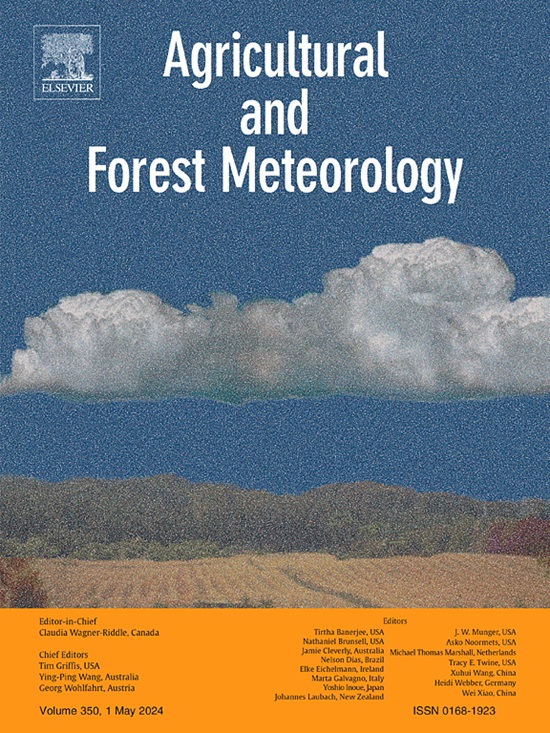Impact of wetland conversion to cropland on ecosystem carbon budget and greenhouse gas emissions in Northeast China
IF 5.6
1区 农林科学
Q1 AGRONOMY
引用次数: 0
Abstract
Wetlands provide a huge carbon (C) sink and represent strategic areas for regulating climate change. However, extensive wetlands have been lost since 1700, primarily for conversion to cropland. Currently, few studies have comprehensively evaluated changes in C budgets and greenhouse gas (GHG) emissions following wetland conversion to cropland. Here, we measured annual carbon dioxide (CO2), methane (CH4), and nitrous oxide (N2O) emissions from a Phragmites australis-dominated wetland and adjacent wetland-converted soybean cropland by combining eddy covariance and chamber methods. We included biomass removal from cropland in the full C and GHG accounting. Annually, the P. australis wetland was a substantial atmospheric CH4 source (50 ± 1 g CH4 m‒2) but strong CO2 (‒1217 ± 162 g CO2 m‒2) and weak N2O (‒0.1 kg N2O ha‒1) sinks, which collectively shaped a big C sink (‒294 ± 44 g C m‒2) and net GHG source (180 ± 164 g CO2-eq m‒2). Converting P. australis wetland to soybean cropland demolished atmospheric CO2 and N2O sinks, and formed net sources of CO2 (140 ± 149 g CO2 m‒2 yr‒1) and N2O (1.1 ± 0.2 kg N2O ha‒1 yr‒1). Meanwhile, this conversion greatly reduced CH4 emissions to 1.2 ± 0.5 g CH4 m‒2 yr‒1. Taken together, soybean cropland was a net direct atmospheric C source of 39 ± 41 g C m‒2 yr‒1, while holding a GHG budget of 203 ± 150 g CO2-eq m‒2 yr‒1. Further, grain and straw in cropland were removed during harvest, creating a C loss of 142 ± 18 g C m‒2 yr‒1, and eventually increased GHG budget to 722 ± 165 g CO2-eq m‒2 yr‒1. Consequently, the full GHG debt of wetland-cropland conversion increased by dozens of times to 542 ± 233 g CO2-eq m‒2 yr‒1, 95.8% of which attributed to biomass removal. Overall, our study contributes to growing recognition of C loss risks of wetland conversion to cropland and highlights the importance of straw return in mitigating climate impacts during agricultural activities.
湿地转为耕地对中国东北地区生态系统碳收支和温室气体排放的影响
湿地是巨大的碳(C)汇,是调节气候变化的战略区域。然而,自 1700 年以来,大面积的湿地已经消失,主要原因是湿地被转为耕地。目前,很少有研究全面评估了湿地转化为耕地后碳预算和温室气体(GHG)排放的变化。在此,我们结合涡度协方差法和室法,测量了一片以葭为主的湿地和相邻湿地转化为大豆耕地后每年的二氧化碳(CO2)、甲烷(CH4)和一氧化二氮(N2O)排放量。我们将耕地的生物量去除纳入了全部碳和温室气体核算。每年,P. australis湿地是大气中大量的CH4源(50 ± 1 g CH4 m-2),但却是强大的CO2汇(-1217 ± 162 g CO2 m-2)和微弱的N2O汇(-0.1 kg N2O ha-1),这共同形成了一个巨大的C汇(-294 ± 44 g C m-2)和温室气体净源(180 ± 164 g CO2-eq m-2)。将 P. australis 湿地转换为大豆耕地则破坏了大气中的 CO2 和 N2O 吸收汇,形成了 CO2(140 ± 149 g CO2 m-2 yr-1)和 N2O(1.1 ± 0.2 kg N2O ha-1 yr-1)的净源。同时,这种转换大大减少了 CH4 排放量,使其降至 1.2 ± 0.5 g CH4 m-2 yr-1。总之,大豆耕地是 39 ± 41 克 C m-2 yr-1 的大气直接碳净来源,同时保持 203 ± 150 克 CO2-eq m-2 yr-1 的温室气体预算。此外,耕地中的谷物和秸秆在收获时被移除,造成 142 ± 18 克 C m-2 yr-1 的碳损失,最终使温室气体预算增加到 722 ± 165 克 CO2-eq m-2 yr-1。因此,湿地-耕地转换的全部温室气体债务增加了数十倍,达到 542 ± 233 g CO2-eq m-2 yr-1,其中 95.8% 归因于生物量的去除。总之,我们的研究有助于人们进一步认识到湿地转化为耕地的碳损失风险,并强调了秸秆还田在农业活动中减轻气候影响的重要性。
本文章由计算机程序翻译,如有差异,请以英文原文为准。
求助全文
约1分钟内获得全文
求助全文
来源期刊
CiteScore
10.30
自引率
9.70%
发文量
415
审稿时长
69 days
期刊介绍:
Agricultural and Forest Meteorology is an international journal for the publication of original articles and reviews on the inter-relationship between meteorology, agriculture, forestry, and natural ecosystems. Emphasis is on basic and applied scientific research relevant to practical problems in the field of plant and soil sciences, ecology and biogeochemistry as affected by weather as well as climate variability and change. Theoretical models should be tested against experimental data. Articles must appeal to an international audience. Special issues devoted to single topics are also published.
Typical topics include canopy micrometeorology (e.g. canopy radiation transfer, turbulence near the ground, evapotranspiration, energy balance, fluxes of trace gases), micrometeorological instrumentation (e.g., sensors for trace gases, flux measurement instruments, radiation measurement techniques), aerobiology (e.g. the dispersion of pollen, spores, insects and pesticides), biometeorology (e.g. the effect of weather and climate on plant distribution, crop yield, water-use efficiency, and plant phenology), forest-fire/weather interactions, and feedbacks from vegetation to weather and the climate system.

 求助内容:
求助内容: 应助结果提醒方式:
应助结果提醒方式:


